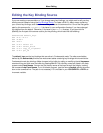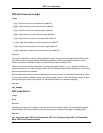
Only the following line commands are allowed in read-only mode:
• ISPF Line Labels - Define a label.
• ISPF Line Command BNDS - Insert a column boundary ruler line.
• ISPF Line Command COLS - Insert a column ruler line.
• ISPF Line Command First - Expose one or more lines at the beginning of a block of excluded lines.
• ISPF Line Command Last - Expose one or more lines at the beginning of a block of excluded lines.
• ISPF Line Command Show - Expose one or more lines having the leftmost indentation level in a
block of excluded lines.
• ISPF Line Command TABS - Displays the tab definition line.
• ISPF Line Command Exclude - Specifies one or more lines to be hidden (excluded).
• ISPF Line Command Select - Select a block of lines.
• Enter places cursor in prefix area - When this check box is selected, the Enter key places the cursor
in the prefix area of the next line. When this check box is cleared, the Enter key places the cursor in
column 1 of the next line.
• Right CTRL = Enter/Send - When this check box is selected, the Enter key places the cursor at the
beginning of the next line, and the Right Ctrl key is used to execute line commands. When this check
box is cleared, the Right Ctrl key acts like a normal control key and the Enter key is used to execute
line commands.
• Cursor page up/down - When this check box is selected, the display is scrolled up/down until the line
the cursor is on becomes the last/first line displayed, respectively. If the cursor is already on the top/
bottom display line, the display is scrolled one page. When this check box is cleared, page up/down al-
ways scrolls one page.
• END command saves the file - When this check box is selected, changes to the buffer are saved
automatically when the ispf_end (F3) command is performed. Otherwise, you will be prompted if you
want to save changes before closing the file.
• XEDIT line commands - When this check box is selected, the prefix area will support XEDIT-style line
commands.
• Home places cursor on command line - When this check box is selected, the Home key places the
cursor on the command line. By default, this option is off, and the Home key simply moves the cursor to
the beginning of the line.
Further ISPF-related options are available on the General Tab of the Extension Options dialog box (Win-
dow → Preferences, expand SlickEdit and click General in the tree, double-click the File Extension
Setup setting). These options include Auto CAPS mode and editing of boundaries and the truncation
column.
ISPF Primary Commands
502


















